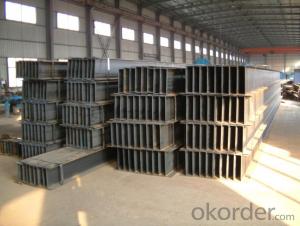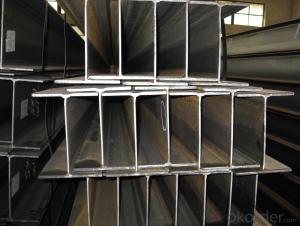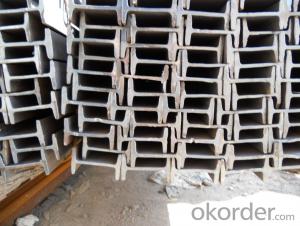GB Standard Steel H Beam 200mm-250mm with High Quality
- Loading Port:
- China main port
- Payment Terms:
- TT or LC
- Min Order Qty:
- 40 m.t
- Supply Capability:
- 15000 m.t/month
OKorder Service Pledge
OKorder Financial Service
You Might Also Like
Specifications of GB Standard Steel H Beam 200mm-250mm with High Quality For Sale:
1. Standard: GB Standard
2. Grade: Q235
3. Length: 12m
Size and Mass:
| Size (mm) | Mass (Kg/m) | Size (mm) | Mass (Kg/m) |
| 200*200*8.0 | 49.9 | 250*125*6.0 | 29.0 |
| 248*124*5.0 | 25.1 | 244*175*7.0 | 43.6 |
Usage & Applications of GB Standard Steel H Beam 200mm-250mm with High Quality For Sale:
Commercial building structure ;Pre-engineered buildings; Machinery support structure; Prefabricated structure; Medium scale bridges; Ship-building structure, etc.
Production flow of GB Standard Steel H Beam 200mm-250mm with High Quality For Sale:
Material prepare (billet) —heat up—rough rolling—precision rolling—cooling—packing—storage and transportation
FAQ:
Q1: Why buy Materials & Equipment from OKorder.com?
A1: All products offered byOKorder.com are carefully selected from China's most reliable manufacturing enterprises. Through its ISO certifications, OKorder.com adheres to the highest standards and a commitment to supply chain safety and customer satisfaction.
Q2: How do we guarantee the quality of our products?
A2: We have established an advanced quality management system which conducts strict quality tests at every step, from raw materials to the final product. At the same time, we provide extensive follow-up service assurances as required.
Q3: How soon can we receive the product after purchase?
A3: Within three days of placing an order, we will arrange production. The shipping date is dependent upon the quatity, how many sizes you want and the plan of production, but is typically 1 month to 2 month days from the beginning of production.
Images of GB Standard Steel H Beam 200mm-250mm with High Quality:
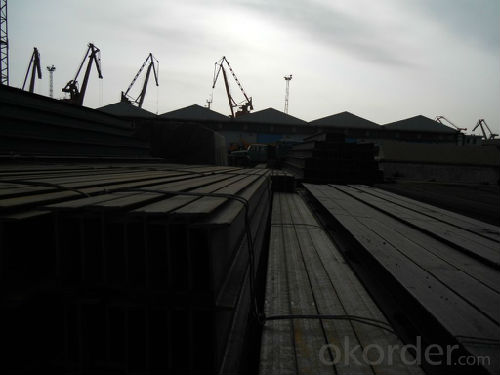
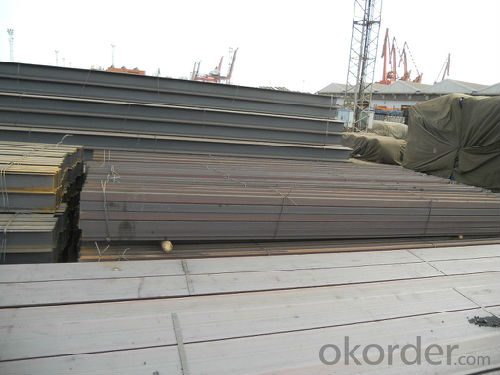
*If you would like to get our price, please inform us the size, standard/material and quantity. Thank you very much for your attention.
- Q:What are the installation requirements for steel H-beams?
- The installation process for steel H-beams depends on several factors, including the application, load requirements, and structure design. However, there are general guidelines that can be followed. 1. Approval from a Structural Engineer: Before installing steel H-beams, it is crucial to seek the approval of a structural engineer who can evaluate the project's specific requirements and authorize the installation. 2. Preparation of the Site: The ground where the H-beams will be installed must be adequately prepared. This may involve clearing obstructions, leveling the ground, and establishing a stable foundation. 3. Lifting and Handling: Steel H-beams are heavy and require appropriate equipment like cranes or forklifts for lifting and positioning. Safety precautions must be followed during this process. 4. Alignment and Leveling: It is essential to ensure precise alignment and leveling of the H-beams according to the design specifications during installation. Laser levels or other alignment tools can assist in achieving this. 5. Connection Methods: H-beams are typically connected to other structural members using welding, bolting, or a combination of both. The specific method depends on design requirements and load considerations. 6. Welding: Certified welders should perform welding connections, adhering to industry standards and guidelines. Proper techniques, including pre-heating and post-welding inspections, ensure structural integrity. 7. Bolting: Connections made using bolts should utilize appropriate grade bolts and nuts. The engineer's torque specifications should be followed to achieve the required connection strength. 8. Bracing and Temporary Supports: Temporary supports or bracing may be necessary during installation to hold the H-beams in place until permanent connections are made. These supports must be designed and installed correctly for safety. 9. Inspection and Quality Control: Regular inspections should be conducted during installation to ensure compliance with all requirements and proper installation of the H-beams. Quality control measures must be implemented to identify any defects or deviations from design specifications. It is important to note that the installation requirements for steel H-beams can vary depending on the specific project and engineering requirements. Therefore, consulting a qualified engineer or contractor is recommended to receive detailed guidance and ensure a safe and efficient installation process.
- Q:How do steel H-beams perform in areas with high humidity?
- Steel H-beams are renowned for their remarkable strength and durability, making them a favored option for diverse construction projects. In terms of regions with elevated humidity levels, steel H-beams exhibit exceptional performance. One of the primary merits of steel lies in its ability to resist moisture and corrosion. Usually, steel H-beams are coated with protective finishes or galvanized to enhance their resistance against rust and corrosion. These coatings function as a barrier, preventing moisture from infiltrating the beam's surface and causing harm. High humidity can result in the accumulation of moisture in the atmosphere, which may potentially inflict structural damage on specific materials. However, steel H-beams are immune to this issue. Their sturdy construction and corrosion-resistant coatings ensure their ability to withstand the challenges posed by humid environments. Furthermore, steel H-beams possess excellent load-bearing capabilities, which are vital for areas characterized by high humidity. Moisture in the atmosphere can sometimes weaken certain materials, compromising their structural integrity. Nonetheless, steel H-beams retain their strength and stability, even in humid conditions. It is important to note that regular maintenance and inspections are still necessary to ensure the long-term performance of steel H-beams in high humidity areas. This includes conducting routine checks for any signs of corrosion or damage to the protective coatings. By promptly addressing any emerging issues, the lifespan and performance of the steel H-beams can be maximized. In conclusion, steel H-beams are a dependable choice for areas with high humidity due to their resistance to moisture, corrosion, and their excellent load-bearing capabilities. With proper maintenance, these beams can provide enduring structural support, even in challenging environmental conditions.
- Q:What is a steel H-beam?
- A steel H-beam is a structural beam made of steel with an H-shaped cross-section. It is commonly used in construction and engineering projects to provide support and stability. The H-beam's shape allows it to distribute weight evenly and withstand heavy loads, making it an ideal choice for various applications, such as building frames, bridges, and structural columns.
- Q:Are steel H-beams suitable for use in the construction of sports facilities?
- Yes, steel H-beams are suitable for use in the construction of sports facilities. Steel H-beams are commonly used in construction due to their strength, durability, and versatility. They can withstand heavy loads, making them ideal for supporting large structures such as sports arenas, stadiums, and gymnasiums. Additionally, H-beams provide excellent structural integrity, ensuring the safety and stability of the sports facility. Moreover, steel H-beams can be easily fabricated and installed, allowing for efficient construction and reduced construction time. Overall, steel H-beams are a reliable and cost-effective choice for the construction of sports facilities, meeting the specific requirements and demands of these structures.
- Q:Are steel H-beams susceptible to fatigue?
- Yes, steel H-beams are susceptible to fatigue. Fatigue is the weakening and failure of a material due to repeated stress cycles. Steel H-beams, like any other structural components, can experience fatigue if they are subjected to repeated or fluctuating loads over time. The repeated stress cycles can lead to the initiation and propagation of cracks in the material, ultimately resulting in failure. Factors such as the magnitude, frequency, and duration of the applied loads, as well as the quality and condition of the steel, can influence the susceptibility to fatigue. To prevent fatigue failure, engineers and designers must carefully consider the expected loads and apply appropriate design criteria, such as incorporating safety factors, conducting fatigue analysis, and implementing proper maintenance and inspection programs.
- Q:H steel compared with ordinary steel in the end what are the advantages and disadvantages?
- Easy to machine: easy to connect and install, easy to remove and reuse.
- Q:What are the welding requirements for steel H-beams?
- The welding requirements for steel H-beams are determined by several factors including the specific steel grade, the thickness of the beams, the type of welding process being used, and the intended application of the beams. Firstly, it is important to select the appropriate steel grade for the H-beams. Commonly used steel grades for H-beams include ASTM A36, ASTM A572, and ASTM A992. These grades have different mechanical properties and welding characteristics, so it is crucial to consult the manufacturer's specifications or relevant welding codes to determine the suitable steel grade for the specific application. Next, the thickness of the H-beams is an important factor that affects the welding requirements. Thicker beams may require preheating before welding to control the cooling rate and minimize the risk of hydrogen-induced cracking. Preheating temperatures and durations should be determined based on the steel grade and thickness, and the specific welding code being followed. The type of welding process being used is another crucial consideration. Common welding processes for H-beams include shielded metal arc welding (SMAW), gas metal arc welding (GMAW), and flux-cored arc welding (FCAW). Each process has its own set of requirements in terms of electrode selection, welding parameters, and post-weld heat treatment. Proper fit-up and joint preparation are also important for achieving high-quality welds on H-beams. The beams should be properly aligned and positioned to ensure full penetration of the weld and minimize distortion. Joint preparation, such as beveling or grinding, may be necessary to achieve appropriate groove dimensions for certain welding processes. Additionally, it is important to consider any specific requirements for post-weld heat treatment or inspection. Some applications may require stress relieving or annealing of the welded H-beams to improve their mechanical properties or reduce residual stresses. Nondestructive testing methods, such as ultrasonic or magnetic particle inspection, may be necessary to ensure the integrity of the welds. Overall, the welding requirements for steel H-beams are dictated by the steel grade, beam thickness, welding process, and application. It is essential to consult relevant welding codes, manufacturer specifications, and engineering professionals to determine the specific welding procedures, parameters, and quality control measures necessary to achieve reliable and structurally sound welds on H-beams.
- Q:How do steel H-beams contribute to the overall safety of a structure?
- Steel H-beams contribute to the overall safety of a structure in several significant ways. Firstly, the H-beam's unique shape and design provide superior structural strength and load-bearing capabilities. The horizontal flanges and vertical web of the H-beam create a strong and rigid framework that can withstand heavy loads, such as those from the weight of the building itself or external forces like wind or earthquakes. This ensures the structural integrity of the building and reduces the risk of collapse. Additionally, steel H-beams are manufactured using high-quality steel, which offers exceptional strength and durability. Steel is known for its ability to resist deformation and maintain its shape even under extreme conditions. This property makes H-beams capable of withstanding various stresses and strains that can occur in a structure, such as bending, twisting, or shearing forces. By preventing any significant deformations, steel H-beams help maintain the stability and safety of the entire structure. Moreover, steel is a non-combustible material, making H-beams highly resistant to fire. In the event of a fire, the steel H-beams will not contribute to the spread or intensity of the flames, providing valuable fire protection and containment. This fire resistance property enhances the overall safety of the structure and allows for more time for evacuation and firefighting efforts. Furthermore, steel H-beams are typically used to construct the primary load-bearing elements, such as columns, beams, and frames, in a building's structural system. By using H-beams, the weight distribution is more evenly spread throughout the structure, reducing the likelihood of localized stress concentrations. This even distribution of loads minimizes the risk of structural failure and enhances the overall safety of the building. Lastly, steel H-beams are highly versatile and can be customized to meet specific design requirements. This flexibility allows engineers to optimize the structural design for safety and efficiency, ensuring that the H-beams are appropriately sized, spaced, and connected to withstand the anticipated loads and possible hazards. In conclusion, the use of steel H-beams in construction significantly contributes to the overall safety of a structure. Their superior strength, durability, fire resistance, even load distribution, and customization options all play a crucial role in enhancing the structural integrity and protecting the occupants from potential risks and hazards.
- Q:Are steel H-beams resistant to pests or termites?
- Steel H-beams are highly resistant to pests and termites. Unlike wood, which is susceptible to infestations and damage from insects, steel is an inorganic material that pests have no interest in. Termites, in particular, are known to feed on cellulose, which is found in wood but not in steel. Therefore, steel H-beams provide a strong defense against pest and termite infestations, making them a reliable choice for structural support in buildings and other construction projects.
- Q:What are the limitations of using steel H-beams?
- There are several limitations associated with using steel H-beams. Firstly, steel H-beams are heavy and bulky, which can make transportation and handling difficult. Their weight also makes them more expensive to transport, especially over long distances. Additionally, the size and weight of steel H-beams may require specialized equipment and infrastructure for installation, which can further increase costs. Secondly, steel H-beams have limited flexibility in terms of design and shape. They are typically manufactured in standard sizes and lengths, which may not always align with specific project requirements. This limitation can result in additional cutting, welding, or modification, adding both time and cost to the construction process. Thirdly, steel H-beams are susceptible to corrosion and require regular maintenance to prevent rusting. Exposure to moisture, chemicals, and environmental elements can weaken the structural integrity of the beams over time, reducing their lifespan and necessitating repairs or replacements. Furthermore, steel H-beams have lower resistance to fire compared to other building materials such as concrete. In the event of a fire, the steel beams can lose their strength and structural stability, potentially compromising the safety of the structure. Lastly, steel H-beams have a relatively high carbon footprint due to the energy-intensive processes involved in their production. The extraction of raw materials, such as iron ore and coal, and the subsequent manufacturing processes contribute to greenhouse gas emissions and environmental degradation. In conclusion, while steel H-beams offer excellent load-bearing capacity and structural strength, they come with limitations such as weight, inflexibility in design, susceptibility to corrosion, reduced fire resistance, and a high carbon footprint. These factors need to be carefully considered when choosing steel H-beams as a construction material.
1. Manufacturer Overview |
|
|---|---|
| Location | |
| Year Established | |
| Annual Output Value | |
| Main Markets | |
| Company Certifications | |
2. Manufacturer Certificates |
|
|---|---|
| a) Certification Name | |
| Range | |
| Reference | |
| Validity Period | |
3. Manufacturer Capability |
|
|---|---|
| a)Trade Capacity | |
| Nearest Port | |
| Export Percentage | |
| No.of Employees in Trade Department | |
| Language Spoken: | |
| b)Factory Information | |
| Factory Size: | |
| No. of Production Lines | |
| Contract Manufacturing | |
| Product Price Range | |
Send your message to us
GB Standard Steel H Beam 200mm-250mm with High Quality
- Loading Port:
- China main port
- Payment Terms:
- TT or LC
- Min Order Qty:
- 40 m.t
- Supply Capability:
- 15000 m.t/month
OKorder Service Pledge
OKorder Financial Service
Similar products
New products
Hot products
Related keywords
